**EDDH Tier 1 Endorsement is mandatory to control any station in Hamburg or above!**
### Hamburg ATC Stations| **Station** | **Station ID** | **Login** | **Frequency** | **Remark** |
| **ATIS** | ADH | EDDH\_ATIS | 124.325 | -- |
| **Ground** | DHL | EDDH\_DEL | 121.805 | Delivery, Callsign "Ground" |
| **East Apron** | DHE | EDDH\_E\_GND | 121.705 | -- |
| **West Apron** | DHW | EDDH\_W\_GND | 121.980 | -- |
| **Tower** | DHT | EDDH\_TWR | 126.855 | -- |
| **VFR Tower** | DHR | EDDH\_VFR\_TWR | 121.280 | Relief Station / Event |
| **Hamburg** | HAM | EDDH\_APP | 120.540 | -- |
| **Hamburg West** | HAMW | EDDH\_W\_APP | 134.255 | Relief Station / Event |
| **Arrival** | DHAT | EDDH\_A\_APP | 118.205 | -- |
| **05** | 110.5 | IHHE | 047° |
| **RWY Config** | **Departures/hour** | **Arrivals/hour** |
| 33/23 | 31 | 31 |
| 23/15 | 27 | 27 |
| 33/05 | 27 | 27 |
| 05/15 | 20 | 20 |
| 23/23 | 24 | 24 |
| 33/33 | 20 | 20 |
| 05/05 | 22 | 22 |
| 15/15 | 17 | 17 |
| 33/23 (LVO) | 14 | 14 |
| 23/23 (LVO) | 12 | 12 |
Although the callsign (in reality) is "Hamburg Ground" we use the suffix \_DEL on Vatsim to avoid confusion among pilots.
Hamburg Ground is responsible for enroute and startup clearances for all departing IFR aircraft. VFR aircraft have to call Ground for departure information. For all departures (IFR and VFR) Hamburg Ground is the first station to contact. **Startup:** When startup clearance cannot be given immediately or the pilot is not ready for startup within the next 5 minutes during high traffic situations, the pilot needs to stay on Ground frequency until he receives startup clearance. If an expected startup time (TSAT) exists, the pilot should be informed about it. This procedure might be necessary during events with a lot of outbound traffic. With startup Ground transfers the aircraft to the responsible Apron/Tower station depending on the current stand. **Initial climb clearance:** The initial climb clearance at Hamburg is 5000ft on all published departure procedures. The altitude shall be entered as cleared altitude (CFL) in an appropriate list or tag. **PDC:** The use of PDC (Pre Departure Clearance) is permitted in Hamburg, but not mandatory. The code "EDDH" shall be used. When using startup times, keep in mind not giving “startup approved” in the PDC clearance. ### SIDs| **Waypoint** | **RWY 33** | **RWY 15** | **RWY 23** | **RWY 05** |
| **AMLUH** | G | D | B | C |
| **HABFU** | G | D | B | C |
| **SOKWO** | G | D | B | C |
| **ELSOB** | G | D | B | C |
| **IDEKO** | G | D | B | C |
| **LUGEG** | G | D | B | C |
| **RAMAR** | G | D | B | C |
| **WSN** Weser | G | D | B | C |
***All EDDH OIDs shall be coordinated with Bremen Radar (sector HAM) before IFR clearance is issued.***
Non-RNAV traffic is expected to file EDDH DCT ELSOB in the F-Plan and to inform ATC when requesting clearance. The initial climb for all OIDs is 5000 ft. ### Working with two Departure Frequencies In case both of the approach stations (HAM + HAMW) are online, Hamburg Ground shall add the correct departure frequency as information within the IFR clearance or at the end of the "readback correct" confirmation. This procedure does not need to be applied if only one approach station is online. > ***Readback correct. Departure frequency** \*when passing 2000ft\* **Bremen Radar 120.540 (134.255)*** **Departure Frequencies SIDs:** - To HAM (120.540): AMLUH, LUGEG, SOKWO, RAMAR - To HAMW (134.255): ELSOB, IDEKO, HABFU, WSN **Departure Frequencies for OIDs:** For OIDs, the departure frequency shall be coordinated with Bremen Radar individually.Bremen Radar will inform Hamburg Ground once this procedure needs to be applied.
### Specials **Vectored departures:** The use of vectored departures requires prior coordination with the responsible radar station. An initial altitude to climb shall be provided. **IFR local flights:** IFR local flights are coordinated with the responsible radar controller, who may instruct a different departure procedure, possibly vectored departures. ### Coordinator Delivery **Times of use:** A Coordinator Delivery can be staffed when all other Ground stations except Apron West are manned. The position shows its potential, especially during events. **Role and function:** The Delivery Coordinator supervises the traffic flow at and in the vicinity of the aerodrome. His duties include: - observing airport and surrounding and detect lacks of efficiency - managing departure list, including SID assignment, flightplan check and squawk assignment - Slot management (if needed) - service for text pilots - PDC service - when controllers are busy coordination with adjacent stations The main Delivery is responsible for all requests via voice on frequency. For these duties, it is recommended to use some tools which are not included in the vanilla version of EuroScope. TopSky (included in the DFS\_Pack) offers windows showing the current and predicted operations rate of specific airports or a specific sector. **Measures:** - MDI (minimum departure interval) for specific SIDs to relieve sectors and airports - delays, e.g. for pushback clearance to prevent overload at holding points - observing for potential conflicts at the ground - checking tools for inbounds and coordinating MDIs or MIT (miles in trail) in consultation with radar stations Always make the right level of restrictions. A restriction shall *not* lead to over- or underload of the airport and its controllers. Keep in mind, a measure only shows its effect after a certain time. # Apron (GND) ### Area of Responsibility Hamburg can be staffed with two apron controllers. **East Apron is the main station, which supersedes the area of West Apron.**| **Station** | **Station ID** | **Login** | **Frequency** | **AoR** |
| **East Apron** | DHE | EDDH\_E\_GND | 121.705 | Apron 1 (incl. holding points) |
| **West Apron** | DHW | EDDH\_W\_GND | 121.980 | Apron 2, 4, 5, 6, (GA) |
**Scenery problems:** There are a lot of ground layout mismatches in different default and payware sceneries across all simulators because of the heavy reconstruction of Apron East in the last couple of years (Z1 Blue/Orange, new 50/60s stands). Stands 51-53 at Z3 are the safest option to use for inbound traffic, the 60s stands will likely cause taxiway incursions, so don't assign them.
**Stand 8-12:** Often used for virtual Airlines and additional parking positions for all Airlines. **Stand 42-43:** Virtual Airlines and Cargo. **44-48 stands:** mixed use, parking face west (e.g. business jets, long time parking, cargo extended parking space etc.). Taxi-Out stands for aircrafts with a max wingspan of 25m. **De-Icing:** De-icing in Hamburg is provided directly at the parking position. #### Pushback In Hamburg it is very important to use the apron and its taxiways efficiently. It is useful to instruct pushing traffic creative routings to avoid congestion. For medium to high traffic situations: - make use of the orange and blue line on Z1 - consider straight out pushbacks from gates 3+4 into Z4 - 50s stands: to avoid taxi via Z1, consider pushback directions opposite to the usual traffic flow - Stand 10-12, 40+ at 33 departure: pushback face south and taxi to holding point B1 - **caution:** do not push stand 9 face south, as it will block the intersection #### Taxiways**No checkpoints:** The area of responsibility of East Apron includes the holding points. Checkpoints shown on charts are not applicable on VATSIM, as we do not simulate the Hamburg Airport company operating the apron.
**Outbound traffic:** Z1 should be used towards the active departure runway. South to runway 33/05 and north to runway 23/15. Low traffic or creative routings may deviate from that. If possible, separate west/east outbound traffic at different holding points. In medium to high traffic situations, where waiting in sequence is expected at the holding points, consider B1 for heavy aircrafts (up to aircraft code E), to avoid blocking the Z1/Z5 intersection. Holding points A5 and B3 are only used for runway crossings. **Arriving traffic:** Depending on the landing runway, aircrafts will usually enter the East Apron via B6 or A5/A6. The inbound routing is coupled to the outbound orientation of Z1, so it creates a a clockwise or counter-clockwise traffic flow to the gates. Low traffic or creative routings may deviate from that. **Helipad:** Helipad East between B1 and B3 is not used that often or is closed via NOTAMS. Prefer using Helipad West. Departures directly from the parking position are not permitted. All helicopter traffic needs to air-taxi to the helipad, except helicopters based at the police station. ### Hamburg West Apron (EDDH\_W\_GND)East Apron controls this area, if West Apron is offline. Tower, East Apron and Delivery need to be online before West Apron can be staffed.
#### Parking and Pushback The DFS Pack includes the GroundRadar-Plugin which assigns parking positions by the airline and aircraft. In case of blocked gates, traffic flow/management concerns or pilot request, another position can be used. **80s stands - Low Cost Terminal:** The "low-cost" terminal is located at the west apron, taxiway Y1. Airlines like Easy and Ryanair are positioned here. In busy traffic situations, these stands can also be used for all airlines (up to aircraft code D) to relieve the East Apron. **90s stands - Cargo:** Stands 91-93 (taxiway Y3) are intended for heavy aircrafts and block their respective A/B positions. Narrow body airliners with a max-wingspan of 36m shall use one of the A/B positions. **Pushbacks at the northern stands (81, 82, 91) need to stay clear of D1:** Either a pushback face north, straight back or a short pushback face south needs to be issued, since D1 is in the responsibility of Tower. Depending on the departure runway, aircrafts facing north might need extensive coordination, e.g. an intersection take-off or a longer taxi-route with a released taxiway D1. **General Aviation (GA + Apron 4):** General Aviation Parking is between D1 and G (green area). Apron 4 is the General Aviation Terminal (GAT) and is often used by smaller business jets or commercial props.**Movement at GA delegated to Tower (green area):** Taxiing out of and into the general aviation parking area is delegated to tower to ensure a steady traffic flow. Parking positions are not assigned to arriving traffic. Outbound traffic should be handed over to tower when they report ready for pushback or taxi, whichever comes first.
**Apron 5 + 6:** Lufthansa Technik - these aprons are only used on pilot request. Apron 6 taxi out needs to be coordinated with tower. In real life these aprons are private property and often a push/pull out through the gates is needed. This is not applicable on Vatsim. **De-Icing:** De-icing in Hamburg is provided directly at the parking position. **Police and rescue helicopters:** The police helicopters are based at Hamburg Airport east of apron 5 (H Pol1 / H Pol 2), Callsign "Libelle". These helipads are not reachable via air-taxi and can only be used for direct arrival/departures. Pilots will communicate directly with the tower. There are no rescue helicopters located at the airport but within the area of the tower control zone. #### Taxiways **Outbound traffic:** Use G for outbound traffic unless an intersection take-off (e.g. D8/D9) was coordinated. In that case airplanes hold short of D1 while being handed over to Tower. **Arriving traffic:** Expect aircrafts on all possible entry points of your area of responsibility and check the provided stand assignment. If you disagree with the chosen stand, coordinate in time with the other stations. Tower will transfer airplanes on D1 with an instruction to hold short of Y3 or Y1. Clear the traffic on D1 as quick as possible. **Helipads:** Helipad West is the main arrival/departure point for helicopters in Hamburg. Departures directly from the parking position are not permitted. All helicopter traffic needs to air-taxi to the helipad, except helicopters based at the police station. ### Taxiway Restrictions Unless otherwise stated below, taxiways are suited for aircraft code F movements. For information regarding aircraft dimensions consult the [Aircraft Performance Database](https://contentzone.eurocontrol.int/aircraftperformance/default.aspx). ICAO aircraft code definitions can be found at [Skybrary](https://skybrary.aero/articles/icao-aerodrome-reference-code). Euroscope:* Ground View > Functions > Maps > Restrictions* *[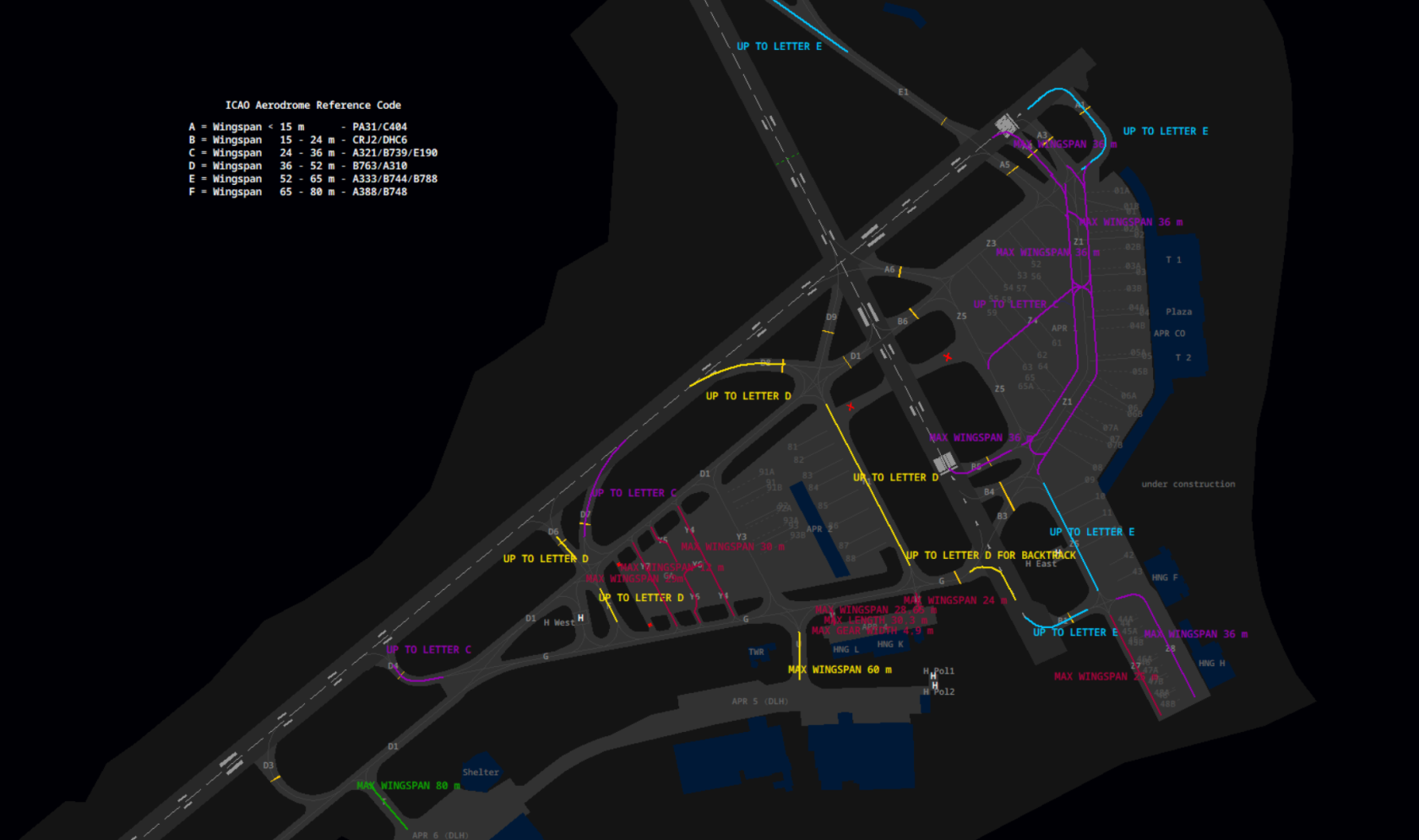](https://knowledgebase.vatsim-germany.org/uploads/images/gallery/2023-10/eddh-taxi-restrictions.png) click to open bigger view* #### Apron East| **Taxiway** | **Restrictions** |
| **Alpha 1** | Aircraft code E or below |
| **Alpha 4** | max wingspan 36m |
| **Bravo 1** | Aircraft code E or below |
| **Bravo 5** | max wingspan 36m, Aircraft code C or below |
| **Zulu 1** | Orange und Blue Line: max wingspan 36m |
| **Zulu 4** | Aircraft code C or below |
| **Zulu 5** | south of Z1: Aircraft code E or below |
| **Zulu 7** | max wingspan 25m |
| **Zulu 8** | max wingspan 36m |
| **Taxiway** | **Restriction** |
| **Foxtrott** | Aircraft code D or below |
| **Golf** | for pushback: Aircraft code D or below |
| **Tango** | max wingspan 80m; >80m tow to Apron 6 |
| **Uniform** | max wingspan 60m; >36m tow to Apron 5 |
| **Victor** | max wingspan 28,65m max length 30,3m landing gear width 4,9m |
| **Whiskey** | max wingspan 24m, **closed** |
| **Yankee 1** | Aircraft code D or below |
| **Yankee 4** | max wingspan 30m |
| **Yankee 5+6** | max wingspan 12m |
| **Yankee 7** | max wingspan 29m |
| **Holding Point** | **Restrictions** |
| **Delta 4** | Aircraft code C or below |
| **Delta 6** | Aircraft code D or below |
| **Delta 7** | Aircraft code C or below |
| **Delta 8** | Aircraft code D or below |
| **Echo 4** | Aircraft code E or below |
| [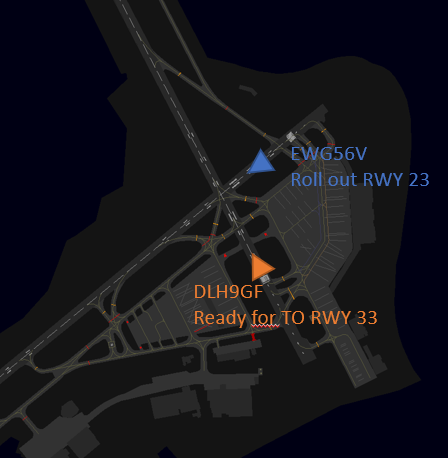](https://knowledgebase.vatsim-germany.org/uploads/images/gallery/2023-11/mafimage.png) | [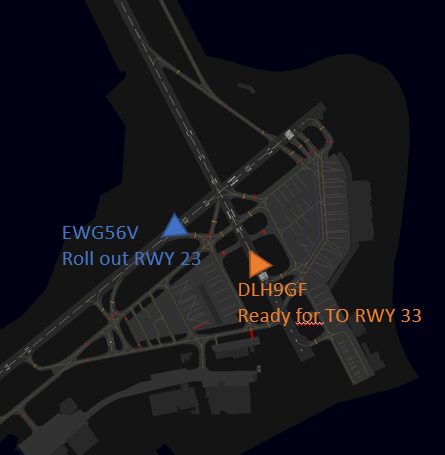](https://knowledgebase.vatsim-germany.org/uploads/images/gallery/2023-11/oIaimage.png) |
| **Runway 33 blocked!** | **Runway 33 clear, a take-off clearance can be issued** |
**Movement at GA delegated to Tower (green area):** Taxiing out of and into the general aviation parking area is delegated to tower to ensure a steady traffic flow. Parking positions are not assigned to arriving traffic. Outbound traffic should be handed off to tower when they report ready for pushback or taxi, whichever comes first.
### Departures **General Departure-Release:** Departures do not have to be released by EDWW (Bremen Radar) unless: - EDWW explicitly restricts departures by time, SID or until further notice - Departures out of the non operational runway config - The first departure after a runway change - The first departure after an unplanned missed approach - Departures using OID or vectored departure **Auto-Handoff:** Hamburg has an auto-handoff to the departure frequency when passing 2000ft, as stated in the charts. A short "bye bye" at the end of the take-off clearance can help vPilots to get the hint. **Spacing:** Departures shall be separated with a minimum of 3nm or wake turbulence separated, whichever is greater. When two aircrafts have the same SID the separation shall be increased to 5nm or wake turbulence separation whichever is greater. Different aircraft performances and climb speeds need to be taken into account. **Efficiency:** Try to sequence departures with alternating SID directions, left/right in relation of the runway track. In case of two westbound departures (different SIDs) out of runway 33, more spacing (5nm) is preferred but not mandatory, as all aircrafts fly the same route until ELSOB. As there are distinct landing and departure runways, use lineups constantly to issue take-off clearances as soon as possible. ### Arrivals **Approaches:** By default, the ILS Approach is used for all arrivals, except runway 33 or coordinated otherwise. **Runway 23 (very often)**: The target spacing is only 3nm on runway 23. In high traffic situations pilots need to vacate as soon as possible. Most of the time the phrase "*taxi left via D1, hold short of runway 33*" is used. **Runway 15 (regularly):** The first exit is E4 to the left. Depending on the spacing on the final and planed parking position, long rollouts might be instructed to vacate left via A6 or right via D9. **Runway 05 (some times):** Same as runway 23 pilots should vacate as soon as possible and be guided onto D1. In this case to have enough time for departures out of runway 33 before the next arrival is on short final. **Runway 33 (only at very strong winds):** This RNP only approach is being avoided as long as possible as its path is directly above Hamburg city. All arriving traffic will taxi via E1 to hold short of runway 23 within the responsibility of the tower.One of your primary objectives with arrivals is to keep the runways useable. Unfortunately some vPilots will hold before the holding line blocking the runway, unless you keep them rolling. Issue taxi instructions as soon as possible.
Handover to apron will take place as early as possible, at the latest when reaching the boundary of responsibility. ### Missed Approaches In case of an unplanned missed approach, the Tower controller shall inform Hamburg East Approach immediately. Traffic will be handed over to Hamburg East Approach after coordination.The next departure is always subject to release, if not coordinated otherwise ([Departure Release](https://knowledgebase.vatsim-germany.org/books/coordination/page/departure-release)).
### Efficiency **Sequencing traffic:** Keep up clearances and rolling instructions. A good sequence on default config (23/33) looks like: - Landing Clearance runway 23 - Lineup runway 33 - Cross D1 traffic at runway 33 and send to East Apron - Takeoff Clearance runway 33 - Taxi arrival on D1 hold short runway 33 ### Reduced Runway Separation (RRS) Hamburg Airport (EDDH) is approved to apply the following reduced runway separation minima during day and night:| **Runway** | CAT 1 following a departing CAT 1 or 2 | CAT 2 following a departing CAT 1 or 2 | CAT 1 to 3 following a departing CAT 3 |
| RWY 05/23 | 600 m | 1500 m | 2400 m |
| RWY 15/33 | 600 m | 1500 m | 2400 m |
| **VRP** | **NAV** |
|---|---|
| **N1** | East abeam Kisdorf/Henstedt-Ulzburg |
| **N2** | Large roundabout at federal street B432 |
| **D** | Highway junction A1 and A24 |
| **T1** | Bridge of federal street B75 leading above the railway tracks |
| **T2** | Track harp the cargo rail station Hamburg Süd (Veddel beim Spreehafen) |
| **H** | Marina/Yachthafen Hamburg, River Elbe |
| **P1** | Highway exit A23 Pinneberg-Nord, Radio Tower |
| **P2** | Highway junction A7 and A23 |
Tower, East Apron, and Delivery need to be online before the VFR Tower can be staffed. Usually only staffed at the Hamburg Harbor Festival and the Overload Real-life Event.
In reality the Hamburg VFR Tower is a station to provide precise traffic information using radar coverage and to organize the VFR traffic flow efficiently. Its area of responsibility includes all VFR flights in the area of the control zone, as well as entry/exit/through flights. Traffic circuits and runway clearances remain the responsibility of the normal EDDH\_TWR. In order to provide traffic information with exact and verified altitude information, the EDDH\_VFR\_TWR may assign squawks and delegate the squawk assignment for departing traffic from Hamburg to Apron/Tower. Departures are handed over to the radar tower after takeoff. Individual arrangements can be made for handovers of approaches to Hamburg but for certain runway configurations the Outer Alster is recommended as a visual reference point in the south of the airport. The efficient handling of traffic can only be guaranteed through good cooperation and coordination between the tower and the radar tower. ### Helicopters Departures directly from the parking position are not permitted. All helicopter traffic needs to air-taxi from and to the helipad, except helicopters based at the police station. **Helipad West:** Main arrival/departure point for helicopters in Hamburg. **Helipad East:** Helipad East between B1 and B3 is not used that often or is closed via NOTAMS. Prefer using Helipad West. **Police helicopters:** The police helicopters are based at Hamburg Airport east of apron 5 (H Pol1 / H Pol 2), Callsign "Libelle". These helipads are not reachable via air-taxi and can only be used for direct arrival/departures. Pilots will communicate directly with the tower. **Rescue helicopters:** There are no rescue helicopters located at the airport but within the area of the tower control zone. In EuroScope the surrounding hospitals with helicopter platforms are marked as square with an x inside. The names can be activated with ALT-H. [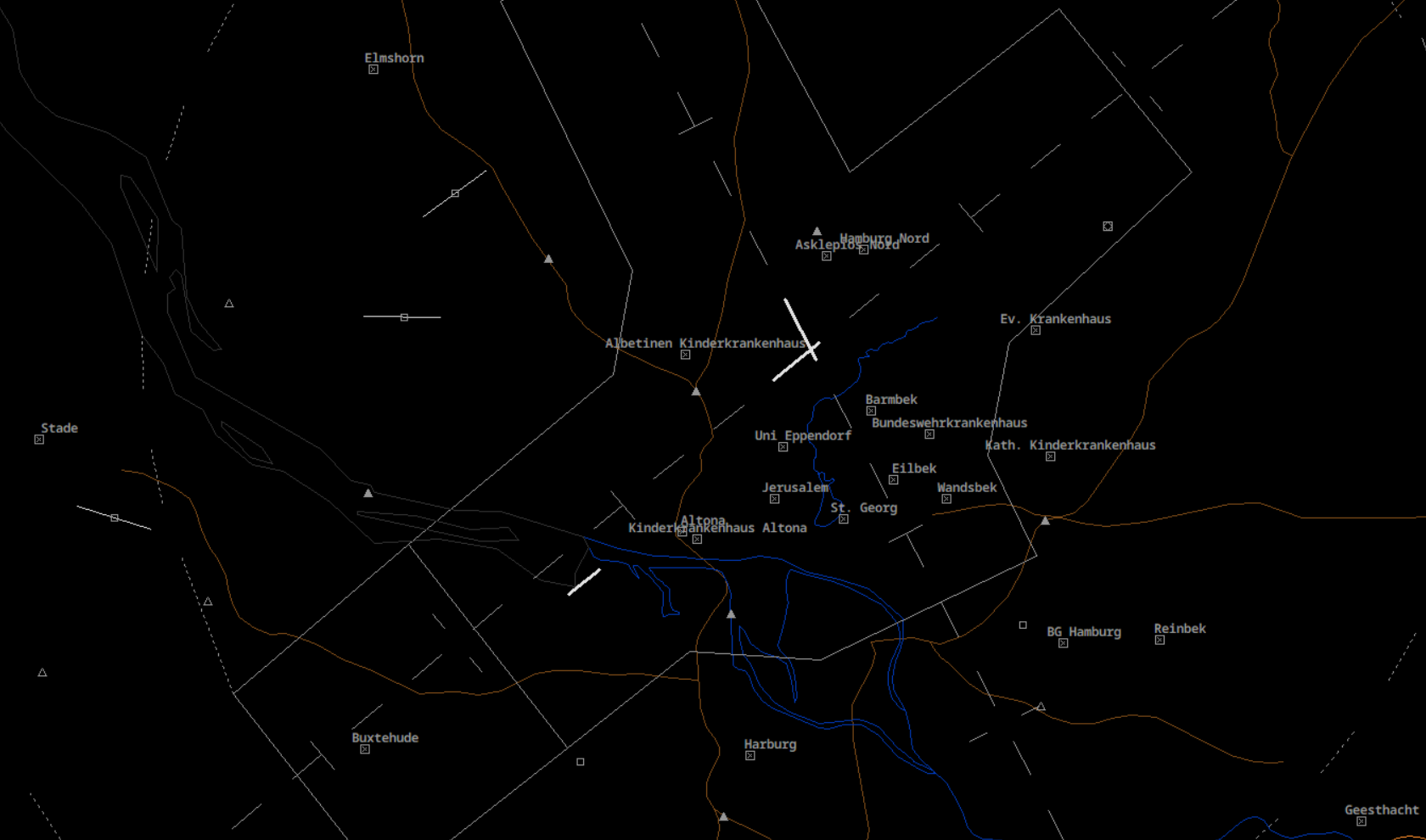](https://knowledgebase.vatsim-germany.org/uploads/images/gallery/2024-05/helipads-eddh.png) ### Low Visibility Operations (LVO) At Hamburg, the following runway configurations are allowed during LVO: - Departures 33\*, Arrivals 23 (preferred configuration) - Departures 23, Arrivals 23 (alternative configuration) Single Runway Operations during LVO requires a larger spacing between arriving traffic. Therefore 33 Departures, 23 Arrivals is the preferred runway configurations whenever RVR and wind permit.\* Note: Runway 33 can only used for departing traffic if the RVR is not less than 150 m.
When the weather condition requires low visibility operations the use shall be announced in the ATIS. At runway 23 the CAT II / CAT III needs to be used.Use ***&lvp*** in the ATIS maker URL or "LOW VIS OPS" flag in the NOTAM menu of vATIS.
# Arrival| **Hamburg** | HAM | EDDH\_APP | 120.540 | Primary Station |
| **Arrival** | DHAT | EDDH\_F\_APP | 118.205 | -- |
| **Hamburg West** | HAMW | EDDH\_W\_APP | 134.255 | Relief Station/Event |
**By default, HAM shall not cross-couple frequency 134.255.**
**Area of Responsibility:** The Hamburg Approach airspace reaches up to FL105 and covers Hamburg Fuhlsbüttel (EDDH), Hamburg Finkenwerder (EDHI) and Lübeck Blankensee (EDHL).The airports Lübeck Blankensee (EDHL) and Hamburg Finkenwerder (EDHI) are covered by HAM in the absence of a tower. Operations at Hamburg Finkenwerder (EDHI) can be in parts/temporarily delegated to EDDH\_TWR, e.g. for a touch and go of a VFR pilot in the EDDH\_TWR CTR.
**[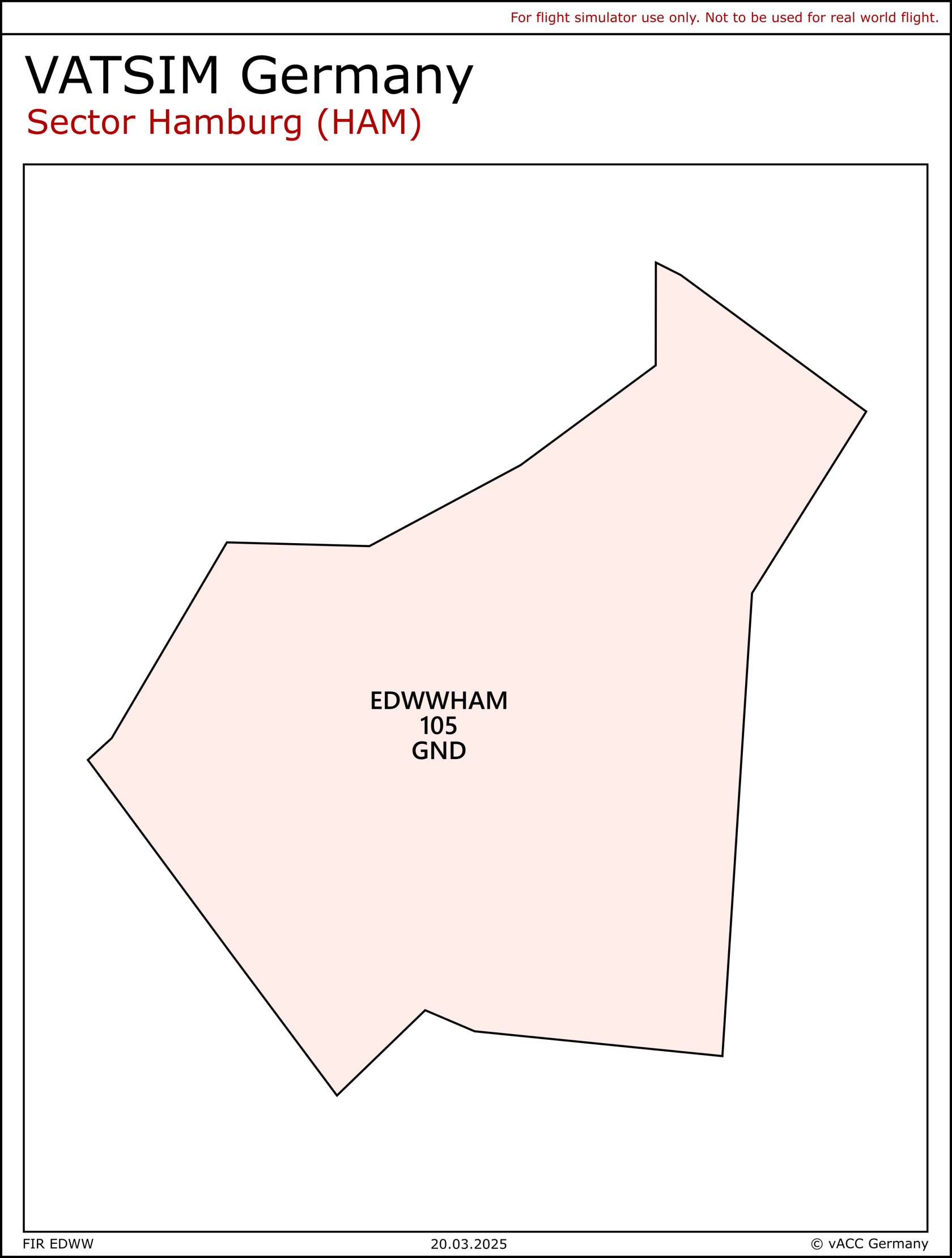](https://knowledgebase.vatsim-germany.org/uploads/images/gallery/2025-02/ham.png)** **Airspace:** The inner ring of airspace C starts at 2500 feet MSL and ends at FL100. Additional rings are similarly dimensioned and start at 3500/4500/5500ft MSL or FL75 respectively. In order to keep arriving IFR traffic inside protected airspace, a TMZ located north of NOLGO between FL60/FL75 and FL100 has been set up.Airspace C (HX) sectors east and west of Hamburg are generally considered active and may be deactivated on pilot's request. Airspace D (HX) west of Finkenwerder is generally active if RWY 05 is in use at Hamburg-Finkenwerder.
[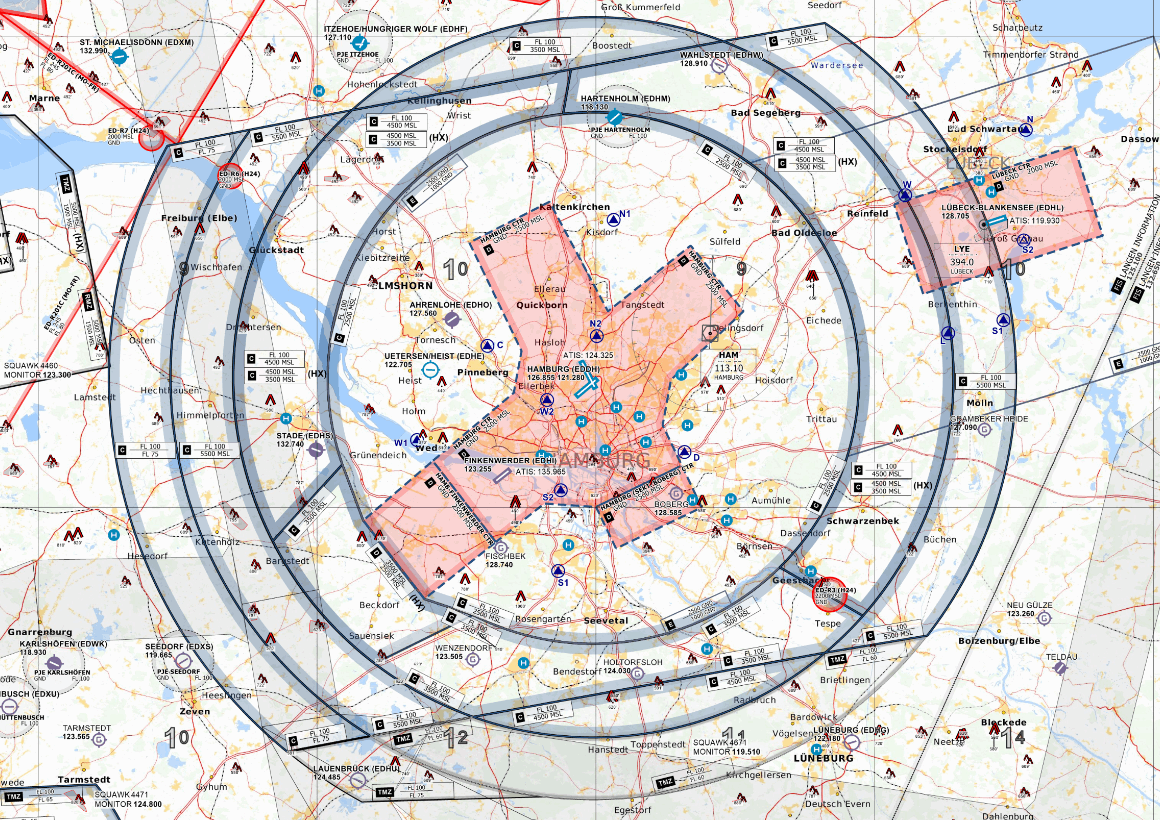](https://knowledgebase.vatsim-germany.org/uploads/images/gallery/2024-01/eddh-tma.png) *Charlie + TMZ Airspace of Hamburg and Lübeck - © [openflightmaps.org](https://www.openflightmaps.org/)* **Minimum Vector Altitude:** The minimum vector altitude can be displayed in the DFS Pack with *Alt + M.* ### Arrivals **Approach types:| **Runway** | **SRE** | **RNP** | **ILS CAT I / LOC** | **ILS CAT II** | **ILS CAT III** |
| **23** | |||||
| **05** | |||||
| **15** | |||||
| **33** |
If possible, all flights to/from Hamburg and Finkenwerder should be kept within controlled airspace (TMZ/D/C). In Lübeck, the procedure is not applicable due to the airspace structure.
### Hamburg Arrival Hamburg Arrival is responsible for all arriving aircraft at EDDH and EDHI. There is no area of responsibility for Hamburg Arrival. The transfer from Bremen Radar to Hamburg Arrival shall be done when the aircraft is cleared for the downwind as coordinated. ### Sector Hamburg West Sector Hamburg West is a fictional working position to be used during events, as the traffic amount on Vatsim can exceed real-world capacities. Furthermore, coordination procedures between APP and ACC differ from the real-world counterpart due to the missing planner positions.Sector Hamburg West shall only be opened if the traffic situation requires. **The opening and closure of this position shall be announced to sectors ALR, HEI, EID and FRI as well as to Hamburg Tower, Hamburg Ground and Finkenwerder Tower.**
When online, Hamburg West will control inbound traffic to EDDH/EDHI via RIBSO. During 23 operations, Hamburg West shall also be responsible for inbound traffic via BOGMU. During 05 operations, HAMW is also responsible for inbound traffic via BOGMU when the northern downwind shall be used (N STARs). **In any case, sectors HAM or HAMW shall inform sector HEI and EID about the responsible sector for inbound traffic via BOGMU.** Additionally, Hamburg West will take over departing traffic from EDDH and EDHI via ELSOB, HABFU, IDEKO and WSN. OIDs are subject to coordination with HAM.Comparable to Hamburg Arrival, Sector Hamburg West does not have its own AoR but operates within the limits of the AoR of sector HAM. Hamburg West shall apply agreements to other sectors as described in the LOP of EDWW ACC for sector HAM. Traffic in the responsibility of HAMW is fully released from HAM.
#### Target separation *In principle, these values are to be understood as minima and should be extended upon request from a tower for VFR traffic. The separations are chosen in a way that the gaps for departures are sufficiently large. Smaller spacing values can be coordinated at any time.* **The wake turbulence separation must be assured!**| Departure Runway | Arrival Runway | Target Separation (nm) |
| 33 | 23 | 3 |
| 33 | 05 | 5 |
| 23 | 15 | 5 |
| 05 | 15 | 5 |
| 05 | 05 | 6 |
| 15 | 15 | 6 |
| 23 | 23 | 6 |
| 33 | 33 | 6 |
| 33 (LVO) | 23 (LVO) | 7 |
| 23 (LVO) | 23 (LVO) | 10 |